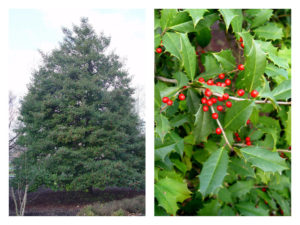American holly
* Common name: American holly
* Botanical name: Ilex opaca
* What it is: American holly is one of the few tree-sized broad-leaf evergreens, offering an alternative screening plant to arborvitae, eastern red cedars, and bug-prone hemlocks for gardeners looking to “go native.”
This holly grows twice as tall as wide and has glossy, leathery, spiny, dark-green leaves year-round. Female trees produce bird-attracting, berry-sized red fruits in fall and early winter. Plant several trees (or at least one male and one female) for best fruiting.
Deer usually don’t bother this holly. The cut berried branches make good Christmas decorations.
* Size: 25 to 30 feet tall and 12 to 15 feet wide in about 25 years. Can be kept smaller with annual shearing. ‘Maryland Dwarf’ is a horizontal version that grows only three feet tall with a spread of about eight feet.
* Where to use: American holly’s sleek, pyramidal habit makes it a good choice for a stand-alone specimen, but a line of them also can be used for tall border screening.
Plants are densest in full sun, but they’ll grow in part shade. Acidic, damp soil is perfect… just not to the point of being soggy. A site out of winter wind helps avoid browning of the foliage.
* Care: Keep soil consistently damp for the first two years to help establish roots, then water is needed only in significant droughts.
If pruning/shearing is needed, do it at the end of winter and as lightly as possible so as to limit the harm to fruiting. Branches also can be pruned in late fall if you’re “harvesting” Christmas decorations.
Work sulfur into the soil at planting if it’s not naturally acidic soil, then scatter a granular, acidifying fertilizer such as Holly-tone or Holly-Care around the base of the trees early each spring.
Cold winters sometimes defoliate whole plants, although they typically fill back in by late spring. Leaf miners also sometimes disfigure the leaves (a non-fatal bug problem).
* Great partner: Red or golden perennials look good around the base, such as daylilies, mums, coreopsis, yarrow, or black-eyed susan. Spirea Mellow Yellow or Glow Girl make nice gold-leafed shrub partners. Golden daffodils are an ideal early-spring pairing.








